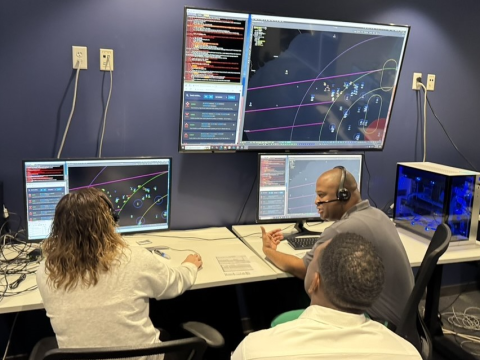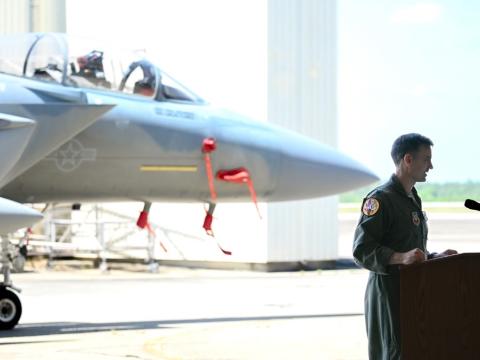Materially Altering Technology
-SEP11.jpg) |
| These snapshots in time show a beam exciting a prism made of square loops. The metamaterial prism shows positive or negative refraction angle. No natural materials contain a negative index of refraction. Scientists have discovered a manmade material that can support negative index of refraction. Manipulation of this may be a way to tune response in real time. |
A research project funded by the U.S. Air Force and taking place among academics in Texas is advancing a new class of metamaterials that could open up a range of applications for defense requirements. By finding new methods for creating synthetic compounds, scientists believe they can develop nanomaterials with properties better suited for products such as electronics than anything found in nature.
Titled Novel Exotic Features of Metamaterials and their Electromagnetic Applications, the project is funded through the Air Force Office of Scientific Research (AFOSR) Young Investigator Research Program. Its research focuses on theoretical modeling and applications of artificial materials with exotic properties beyond what occur naturally. Dr. Andrea Alù, an assistant professor at the University of Texas at Austin with a doctorate degree in electrical engineering, is heading the effort.
The project has several direct implications in a variety of fields that interest the Air Force, Alù explains. He says scientists will be able to realize multiple benefits, including more efficient and smaller sensors, smaller electronic devices and switches, larger bandwidths of operation for communication devices, higher efficiencies for energy harvesting, frequency conversion, nonlinear operation, scattering suppression, enhancement and redirection. “We believe that all these concepts can affect military technology on the field in the near future,” he states.
Work on the AFOSR project has two main goals: to make a lasting impact on the theoretical understanding of the unconventional way metamaterials interact with electromagnetic waves; and to apply their anomalous scattering properties to miniaturize devices and obtain electromagnetic responses unavailable now, particularly in the visible domain. “Currently, metamaterials are characterized and modeled on the basis of homogenization schemes a century old, developed to describe natural materials and simple composites,” Alù explains. “However, their complex wave interaction requires new methods and schemes to properly and successfully describe their wave interaction. Our most recent theoretical results in this sense have solved several outstanding issues relative to the possibility of describing metamaterials as homogeneous materials, capturing all their complex responses within a limited set of constitutive parameters. These findings will tremendously facilitate the design and modeling of novel devices with unconventional properties, of great interest for various Air Force applications.”
He adds that, “In parallel to these important results, we have proposed concepts for novel optical devices involving nanostructured metamaterials with groundbreaking properties for sensing, switching and energy harvesting. Our concepts of ‘plasmonic Brewster’ transmission and of bistable index of refraction, for instance, have recently appeared in two Physical Review Letters,” a journal of the American Physical Society (APS). The papers were both published in March.
The findings will help others better describe how electromagnetic waves interact with metamaterials. An index of refraction tells how the waves interact with a substance. The numbers used for natural materials often are inaccurate for metamaterials. Previously, researchers had problems when trying to use the natural parameters to describe metamaterials in a homogenous—instead of atom by atom or molecule by molecule—manner. The physical laws inherent in the parameters often were violated.
His team’s findings enable a way to describe more accurately metamaterials as homogenous and therefore apply them in new ways to devices and designs in fields such as microwaves and infrared.
“My research for the U.S. Air Force focuses on the anomalous scattering properties that these manmade materials possess, offering the possibility to bend and diffract electromagnetic waves in unconventional ways,” Alù explains. “My research team is currently working on various aspects of metamaterial science and technology, from their rigorous theoretical modeling and understanding to their practical applications in a variety of novel devices, such as ultracompact switches and sensors, anomalous scattering objects and dynamically tunable nanodevices.”
Fellow researchers on the Air Force project include one graduate student and one undergraduate student. Work with the Young Investigator award funding began in April 2011 and will continue for three years until March 2014. However, Alù has been working with the Air Force Research Laboratory (AFRL) since September 2009. His entire research team at the university in the Metamaterials and Plasmonics group currently consists of one postdoctoral researcher, six graduate students and two undergraduate students but “it is rapidly expanding,” he states.
The Texas scientists also are collaborating with other universities on metamaterials research including an Office of Naval Research Multidisciplinary University Research Initiative focused on optical metamaterials. Fellow participants hail from Harvard, Purdue, Northeastern and the University of Pennsylvania. Alù says the group has “the ambitious goal of realizing a large-scale optical metamaterial with unconventional properties.”
-SEP11.jpg) |
(A) A square-loop metamaterial inclusion loaded by nonlinear optical materials; (B) Its equivalent |
The team has developed a metamaterial formula that allows researchers to have a positive and a negative index of refraction at the same frequency within one sample. No natural materials have a negative index of refraction, and the development of it in metamaterials could enable many different applications, such as superior lenses and cloaking.
Researchers also have proved that their system has a memory that can remember a stable state and change the index of refraction, which can be attractive for metamaterials and would help make the materials tunable. Manipulators then can choose what properties to give them. “It’s something that is not several decades away,” Alù says. “It’s something within reach. It’s a very important step, what we propose,” because it offers a practical way of realizing these types of systems.
The researchers are working actively on experimental concept realization, though the interest is mainly to realize prototypes rather than go to commercialization or large-scale production. However, Alù hopes that within 10 years many of these metamaterials will be benefitting society. He describes the advancements as “a new degree of freedom” with which developers can choose the properties of their materials by tweaking the artificial atoms composing them.
Several scientists at the AFRL with whom he continuously interacts have shown interest in these most recent findings on metamaterial modeling and characterization, “and we have been very happy to interact and share our results,” Alù says. “This has led to an important exchange of information, feedback and expertise that greatly benefits both us and the Air Force.”
According to the Air Force, it can gain from advancements in this field that could enhance data processing rates, bandwidth and the size of optical devices on aircraft. The service’s far-term goal is to enable future optical devices to work based on propagation, filtering and manipulation of light instead of on electrons. Success could lead to smaller and faster devices.
“I can say that Dr. Alù is one of the most talented young scientists working in the area of materials/composites exhibiting novel electromagnetic properties,” says Dr. Arje Nachman, the program manager at AFOSR. “While it is easy enough to simply imagine that some composite has electromagnetic properties corresponding to, say, its having negative permittivity and permeability ... it is quite another matter to provide anyone with some guidance for fabricating such a composite given that most elements in the periodic table—from which, after all, any composite would ultimately be made—don’t have negative permittivity and permeability. It is, however, the case that the effective (bulk) attributes of composites can be very different from their constitutive elements, and Dr. Alù is in the forefront of the effort to identify and pursue the subtle mathematics that, when done correctly, predicts these bulk properties,” Nachman continues. “His work will be an important step in hopefully providing the Air Force with such things as ultracompact switches and sensors and dynamically tunable nanodevices.”
This work also could put forward significant new concepts for nanotechnology devices. Metamaterial itself is a relatively new field of study, with efforts in the area beginning about 10 years ago. Understanding of the concepts is still limited; Alù and his partners believe that their research can make a lasting impact in the field and revolutionize the way metamaterials are described, designed and realized. “Our approach combines rigorous analytical tools, extensive numerical simulations and experimental verification,” he says.
Over the scope of the three-year AFOSR project, Alù envisions opening a variety of practical scenarios of interest for research and development of the concepts he presents. “We hope to be able to bring to fruition some of these ideas within practical devices,” he states. After that, researchers can take what he has learned and proved to move forward. “The next steps will consist of realizing and testing some nanofabricated prototypes of the metamaterial devices we are currently exploring,” Alù shares. “This will be the first step towards the practical implementation of these devices for Air Force applications on the field.”
Alù recently attracted special attention for his work with metamaterials. This year he received the URSI (the French acronym for International Union of Radio Science) Issac Koga Gold Medal, awarded triennially for career achievement in the field of electromagnetics and radio science. The citation for the honor reads: “For contributions to the theory and application of electromagnetic metamaterials, in particular the conception of plasmonic-based cloaking, optical nanocircuits, and anomalous propagation and radiation in metamaterials.” He picked up his medal in August at the URSI General Assembly and Scientific Symposium in Istanbul, Turkey.
Though the award refers to a career achievement rather than to results directly obtained during his AFOSR-funded work, Alù says it definitely is related to the concepts worked on in the recent past within the AFOSR Young Investigator award.
Alù enjoys his work on the Air Force project because he says the funding authorities, and Dr. Nachman in particular, allow his team freedom to investigate and answer fundamental basic-research questions. He also is pleased with the possibility of advancing military technology and the entire research and scientific community. Though his projects from the Air Force and Navy are distinct, in some cases they can leverage one another and receive input from the various organizations involved. “It’s really a very exciting area to work in,” he says. “There are a lot of things to be done.”
WEB RESOURCES
Young Investigator Research Program: www.wpafb.af.mil/library/factsheets/factsheet.asp?id=9332
URSI: www.ursi.org




Comments